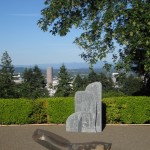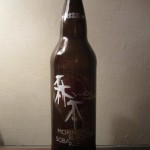WIT Life #236: Japanese Influence in Portland
WIT Life is a periodic series written by professional Writer/Interpreter/Translator Stacy Smith (Kumamoto-ken CIR, 2000-03). She starts her day by watching Fujisankei’s newscast in Japanese, and here she shares some of the interesting tidbits and trends together with her own observations.
I’m on the tail end of a business trip in Portland, my first visit to the state of Oregon. Being located on the West Coast I had assumed there would be significant Japan connections, and was happy to find that I was right. One of the first places I went to was the Japanese Gardens, proclaimed to be the “most authentic Japanese garden outside of Japan.” The 5.5 acre grounds are sprawling, and include natural gardens, sand and stone gardens, and a tea garden. The timing of our visit was great, as they were having a special Isamu Noguchi exhibition as part of their “Art in the Garden” series (through July 21). It was neat to see some of Noguchi’s pieces, on loan from his LIC museum, juxtaposed against the backdrop of the Portland skyline.
I also found a J apan connection when I checked out the local Rogue Brewery one night. One of their many offerings was the Morimoto Black Obi Soba ale, a richer and nuttier version of the brewery’s original Morimoto Soba Ale. They also feature a Morimoto Imperial Pilsner, which is golden in color, floral in taste, and described as a “hedonistic mouthful.” All three are part of the 2003 Morimoto Signature Series, a collaboration between Rogue and Chef Masaharu Morimoto. I only got to drink the Black Obi as there were other types of beer I also wanted to sample, but it was good enough to make me want to go back and try the other Morimoto varieties next time.
apan connection when I checked out the local Rogue Brewery one night. One of their many offerings was the Morimoto Black Obi Soba ale, a richer and nuttier version of the brewery’s original Morimoto Soba Ale. They also feature a Morimoto Imperial Pilsner, which is golden in color, floral in taste, and described as a “hedonistic mouthful.” All three are part of the 2003 Morimoto Signature Series, a collaboration between Rogue and Chef Masaharu Morimoto. I only got to drink the Black Obi as there were other types of beer I also wanted to sample, but it was good enough to make me want to go back and try the other Morimoto varieties next time.
As expected, Portland has deep ties to the Japanese American community. One of the main highways is named after the late Bill Naito, who was a business leader and philanthropist in the city. In addition, there is a Japanese American Historical Plaza that commemorates “the hardships suffered by Japanese immigrants and the indignities imposed by the incarceration of persons of Japanese ancestry during World War II.” The waterfront location was selected as it is where the pre-war Nihon Machi (Japan Town) was located. I didn’t have a chance to get there during this trip, but plan to make it there on my next one.


Comments are closed.